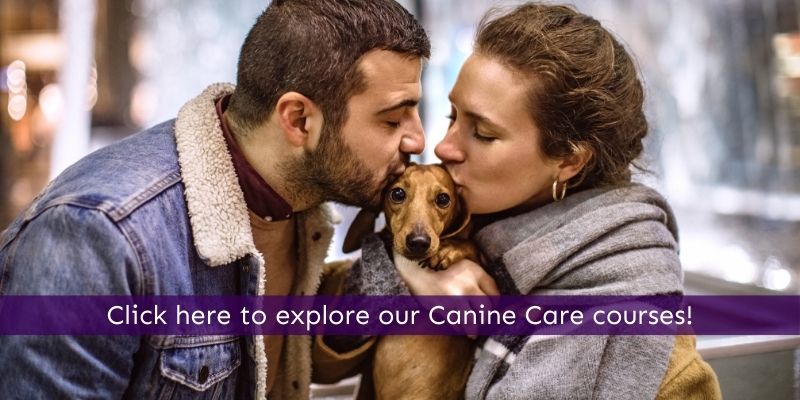Many dogs are resilient and adapt to changes quite easily, but others find change difficult.
We know that sudden changes in routine or household members suddenly not being around can contribute to problem behaviour. Separation anxiety or separation distress is already a problem for some dogs, and it takes a lot of work to improve or change this.
With the measures in place to try to keep us all safe from COVID 19, many of us are having to remain at home. Some dogs will be enjoying the additional time with family members, additional walks and interaction, opportunities to engage in some fun training or mental enrichment.
Please do remember, dogs also need sleep and rest! On average, adult dogs need around 14-16 hours per day, depending on the breed.
Some dogs may find the interruptions to their normal days unwelcome. Some dogs may find themselves full of adrenaline from increased fast paced chasing games and unable to settle down afterwards. Other dogs will be trying to cope with the additional interaction from family members, when they would rather have a snooze.
As we struggle with being confined at home, we often inadvertently give more attention to our dogs. After all, we get oxytocin from interacting with them – the love hormone!
The most reported predisposing factor in separation anxiety problems in dogs is said to be a sudden episode of enforced separation from the caregiver, preceded by a period of prolonged and relatively constant contact.
Some dogs have never learned to cope with separation from the primary attachment figure and/or may have developed an overly intense attachment as a result of experiencing a long phase of constant or exclusive contact.
When we think about separation anxiety and how to change this condition, we find training goes much better (and quicker) if caregivers can take time off work while we work through the issues. NOW, is the ideal time to do something if your dog suffers already with separation anxiety.
We need to be aware that having us at home, for a long period of uninterrupted time, can cause separation issues to appear, when we return to work.
We can avoid this happening with a few simple steps.
- Even if we are unable to actually go anywhere, we can still step outside the house. This could be just outside the front door or even out the back door.
- Doing this twice a day, just for a minute at a time can help prevent future issues.
- Slowly build up the time you remain outside in one-minute increments. If you have a car parked out the front of your house, perhaps you could sit in there for a few minutes each day.
- If you have a stairgate, perhaps consider closing it once or twice a day, just for a few minutes and providing a snuffle mat, licki mat, stuffed Kong or similar enrichment for your dog while the gate is closed.
- If your dog cannot cope with being separated by a stairgate, even for a few minutes and does not engage with the enrichment toy provided, you will need to do desensitisation to very brief periods of absence as he mostly likely already has separation issues.
We may think we will not have an issue when everything returns to normal because our dogs are laid back. It is still worth taking a few steps to ensure our dogs will cope.
If your dog can cope with being the other side of a stairgate, gradually build up the distance you are from the gate while he is behind it. Try to return to open the gate just as he is finishing his enrichment. Over a period of days, slowly build up to being out of sight, before returning to your dog. Providing he does not already have anxiety issues, slowly work up to closing a door and opening it again for longer and longer periods of time. The aim is to do this without your dog experiencing any stress or anxiety at all. If he begins to whine, scratch at the door or bark or destroy items while you do this, you will need an in-depth plan to follow in order to change this. It is advisable to work with a fear free qualified behaviourist to do this.
When we are working with separation issues, we sometimes suggest using an unusual item to signal we are unavailable to our dogs. Many of our dogs will be used to having our attention whenever they need it, constant access to us just because we are home all of the time. Try to think of an object you could use, that currently has no meaning to your dog. This might be gardening gloves, an old hat, an old stuffed toy (as long as your dog doesn’t like playing with these)! Any item will do if it has no real meaning to your dog. When you are all together in a room relaxing, place this object in sight of your dog (but out of reach).
Whenever this object is placed on a table, ignore your dog and read a book, look at your phone, tablet or something else that will take up your attention. Do this for just a few moments. When you finish, put the object out of sight and interact with your dog.
Over several days, slowly increase the time you ignore your dog, taking care to remove the item when you are ready to engage with your dog. This will become a cue (signal) that you are unavailable to him. Some dogs may not be able to cope with this so please observe your dog carefully for any signs of stress.
Once he has learned what this item means and no longer hassles you to engage with him, you are now ready to use the item for leaving the room and building up to leaving the house.
Instead of an item, you might choose to turn on the radio if this is something you do not normally do.
Look out for any signs of stress in your dog while you are doing this training, stress signs include:
- Panting
- Over yawning
- Trembling
- Whites of eyes showing or red membranes around the eyes
- Salivating
- Destructive behaviour
- Frequent lip licking
- Ears back, body held low and tail held low
- Tension on forehead or around the mouth or an open mouth suddenly closing
The aim of this preparation for separation is to avoid stress.
If you are seeking help for various issues with your dog and want to know more about it, or you want to build confidence or reduce fear in your dog, have a look at some of our short courses, in particular the Understanding and Preventing Separation Anxiety course. All our courses are suitable for caregivers, rescues and other professionals.
Also, if you adore animals, you can keep track of all upcoming animal awareness days and events with our FREE calendar! Download it here.

















